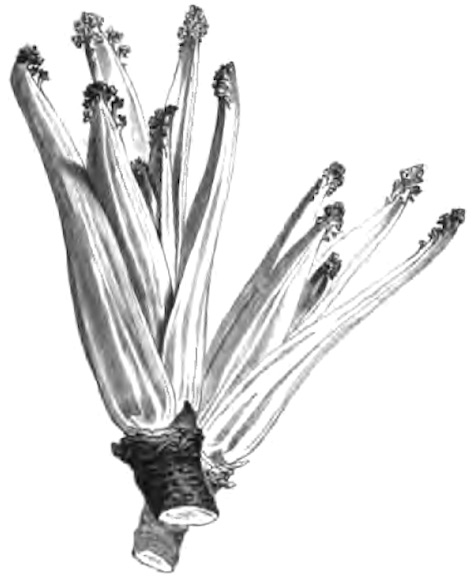 Sea Kale and Other Crambes
Sea Kale and Other Crambes
Overview
- Sea kale is a leaf crop native to European seashores.
- This is a lightly domesticated crop, grown primarily for its spring shoots, but also has edible leaves, roots, florets, and green seed pods.
- This crop is easy to grow in the Pacific Northwest and in much of the rest of the US where summers aren’t very hot.
- Blanched shoots are produced by covering the plants early in the spring.
- Plants should be established for two years before harvesting shoots.
- Varieties are propagated by root cuttings which are traditionally called thongs. It is also common to propagate unimproved varieties by seed.
- Sea kale has several similar relatives that are also edible, including Tartar bread plant and giant colewort.
About Sea Kale
Description
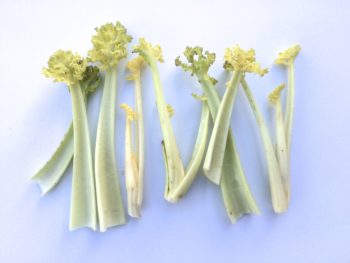
Sea kale (also seakale, Crambe maritima) is a wild plant of northern European sea shores. It has a form very similar to leaf cabbages or collards, although the leaves are thicker. It is most commonly grown for its spring shoots, which are blanched and used like asparagus. All parts of the plant are edible. The florets are very much like broccoli, although smaller. Thousands of small white flowers open over several weeks in the spring and smell strongly of honey.
Sea kale is perennial. When grown for many years, plants can become very large, spreading over a diameter as large as five feet (1.5 m). In the garden, plants are typically much smaller due to continual harvest of new shoots and occasional division of the plants.
The plants are unaffected by frost, but top growth is killed by sufficiently cold temperatures. They typically die here when temperatures fall to about 25° F (-4 C). When not killed by cold weather, the plants naturally senesce in fall or early winter to sprout again in the spring. Flowering occurs here primarily in May and June.
Wild sea kale has a high degree of genetic diversity and that diversity is widespread, rather than concentrated in local populations; this is probably a consequence of the distribution of sea kale seed by the ocean (Bond 2005).
There is a botanical variety of seakale native to the Black Sea, C. maritima var. pontica. It’s seedlings are pubescent (Briard 2002). This variety may be diploid (Sanyal 2015) and therefore could be particularly valuable for breeding. Most varieties of sea kale are tetraploid and therefore are not true breeding.
History

Sea kale was once a common cultivated vegetable in France and Britain, with a small number of named varieties. By the turn of the 21st century, there was no longer any commercial sea kale production in either country (Briard 2002). As with so many of the crops in this book, the reasons for its abandonment lie in difficulties adapting to modern, mechanical agriculture and the perishability of its products.
Although it is a common plant of European seashores, sea kale has disappeared or become uncommon in large parts of its range in recent years, particularly in the UK (Scott 1958).
Sea kale had a brief period of popularity in the United States and was grown by Thomas Jefferson at Monticello beginning in 1809.
In the British Antarctic expedition of 1909, sea kale was grown at Cape Geology in an attempt to establish it. The seeds germinated in native soil, but the plants didn’t survive (Smith 1996).
Interest in sea kale is returning and the first commercial crops in many years are being raised in the UK (Mesure 2014). Along with that, foragers are harvesting wild sea kale and selling it to London restaurants, receiving about $10 per pound. In some cases, they are picking it illegally (Millard 2014). All the more reason to put more sea kale into cultivation!
Lighthouse Sea Kales
Sea kale has naturalized at a few beaches along the west coast of the USA, mostly near lighthouses. Preeminant edimentalist Stephen Barstow suggested that sea kale is probably found near lighthouses because they often had gardens in their early years, before the communities around them were well established, and sea kale was well suited to growing in seaside conditions. These populations most likely escaped their gardens in the late 1800s and early 1900s.
There are existing populations of sea kale at Piedras Blancas in California and Yaquina Head in Oregon. The Yaquina Head population is well documented, first reported in 1915 (Nelson 1918). It was still growing in the same location in 2015, when I visited and collected a small sample to propagate. Since it appeared to be setting a good crop of seed at the time, it would not be surprising if it has spread up and down the coast in the past century. Two people have also reported sea kale growing near Heceta Head lighthouse, but I failed to find it. If you know of this or any other naturalized sea kale population on the west coast, please let me know. I would be interested in collecting and preserving any lighthouse sea kales that still exist.
Nutrition
Although sea kale has many edible parts, nutritional analysis is available only for the principal product: blanched shoots. Nutritional values for leaves are probably not too different from shoots, but florets and roots aren’t likely to be comparable. For best estimates, it seems likely that broccoli and sea kale florets would be similar.
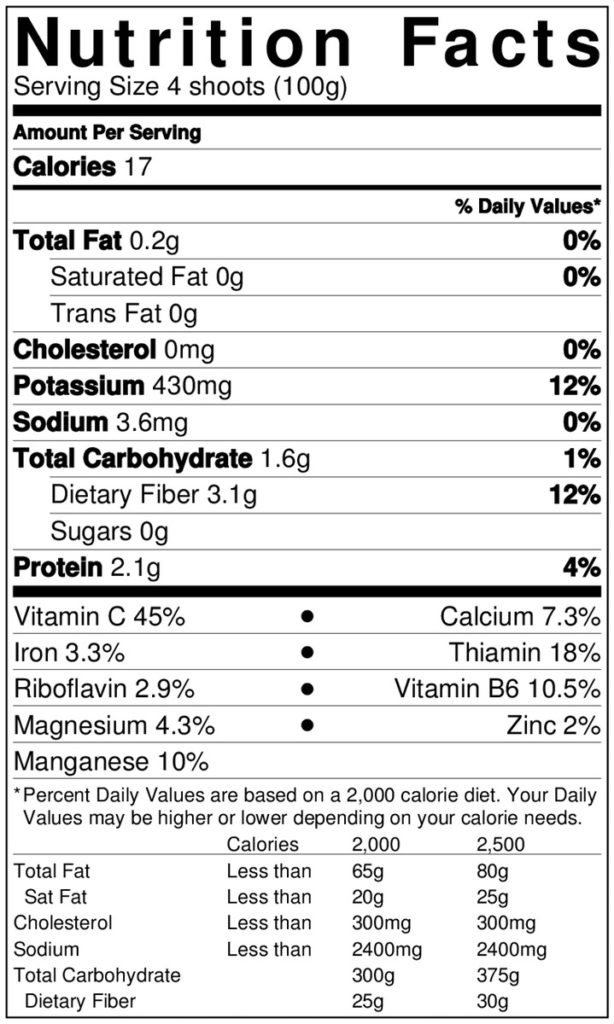 Blanched shoots compare favorably to asparagus in vitamin and mineral content, with similar values overall, but considerably more potassium (Peron 1991).
Blanched shoots compare favorably to asparagus in vitamin and mineral content, with similar values overall, but considerably more potassium (Peron 1991).
Cooking and Eating
The primary product of sea kale traditionally has been blanched shoots, which are said to taste similar to asparagus. They don’t really taste like asparagus to me, but I can’t come up with a better description either. Blanching renders the shoots softer and less bitter and causes them to grow longer than they otherwise would. To do this, put a dark colored bucket or similar light-proof container over the crown of the dormant plant in early spring. Harvest the shoots once or twice as they reach about 8 to 12 inches in length. Don’t get greedy or you can kill the plant. Older plants will survive more harvesting.
The leaves are like a very thick cabbage, but are most people seem to think they are too bitter. I don’t find them to be that bitter and think they make a nice addition to a salad when sliced thinly. A little oil softens them up. They also make a hearty cooked green that doesn’t break down as dramatically as spinach or kale. The leaves can also be fried until crispy (Mesure 2014), something that I haven’t tried yet, but you can bet that I will! People do perceive bitterness differently and I might be less sensitive than some, but I suspect that the bigger difference is probably climate. Sea kale does become more bitter in warmer, drier weather. We are very close to the ocean in an ideal sea kale climate.
The roots can be cooked and are somewhat like rutabaga in flavor, although the plant needs to be about three years old before the roots reach a good size for eating and they can sometimes be unpleasantly fibrous. Seed pods are edible while they are still green. They are juicy and have a pleasant, bittersweet flavor. They make an appealing addition to salads. You probably shouldn’t eat tons of them due to high erucic acid content. This would most likely be a concern only if pressing the seeds for oil. You would have to eat a ridiculous number of seed pods to reach any level of concern that we know about. A berry picking rake makes a good tool for harvesting sea kale pods. The unopened florets might be my favorite part and I think that there is good potential for selecting sea kales that can be used as a kind of perennial broccoli.
Cultivation
Climate Tolerance
Although tolerant of wider conditions in cultivation, sea kale is naturally found where average temperatures range from roughly 40 to 60° F (4 to 16 C) with rainfall ranging from 20 to 80 inches (50 to 203 cm) (Scott 1958). As a seashore plant, it is tolerant of rain, wind, salt spray, and even the occasional salt water inundation.
Sea kale is a very forgiving plant and almost any garden environment will suffice. Sea kale prefers temperatures below 85° F (30 C). It is frost resistant and somewhat drought tolerant, although it grows best with consistent access to water. Wind seems to cause it little problem.
Sea kale probably best fits USDA zone 6, although some sources list it as hardy to zone 4. It might be able to tolerate colder climates if there is snow cover.
Photoperiod
Sea kale has no photoperiod dependencies.
Soil Requirements
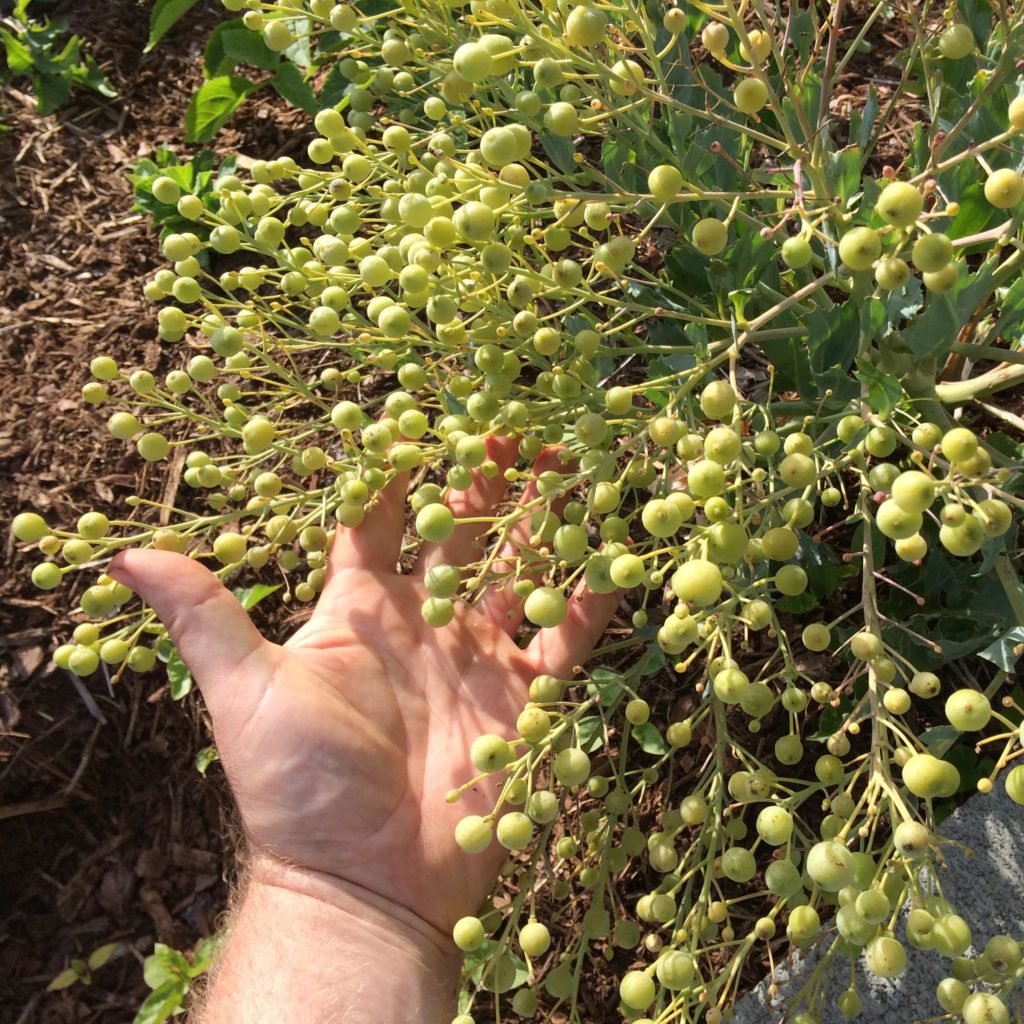
Sea kale likes light, well-drained soils. In it’s native environment (European seashores) it often grows in gravel or shingle, sometimes over clay or sand (Scott 1958). I find that it performs very well in freely draining garden soil though. It responds well to rich amendments like fresh manure, which is rather surprising considering that its natural environment is sandy.
Sea kale is tolerant of salt in soil, but not at high levels. In a rainy environment with well draining soils, it can handle a lot of salt spray, but it is probably not a good candidate for regular watering from brackish sources, much less full strength sea water (de Vos 2010). While the medium (it is hard to call it a soil in many cases) in which sea kale grows natively is likely to be alkaline, the plant seems to be tolerant of a wide variety of conditions. We grow it in mildly acidic soil here and it performs just fine.
Propagule Care
Sea kale is available both as seed and as root cuttings, known as thongs. Seeds are more affordable, but take some time to get started. Starting sea kale from seed is much like starting cabbage from seed. Thongs give you a year head start – they are like having a second year plant. When growing from seed, you generally will want to wait until the third year before you cut the spring shoots; if you started from thongs, you can begin to take shoots the following year.
Sea kale thongs are root cuttings, usually 4 to 6 inches (10 to 15 cm) in length. One or both ends may be cut. They store best in the ground, so the best practice is to plant them immediately if the weather permits. Sea kale is a cold hardy plant and thongs should survive late planting to at least USDA zone 6.
If conditions are too cold to plant them, they will store through the winter if kept below 50° F (10 C) in a humid environment. You can also pot them in damp sand or soil, in which they generally keep better.
Sea kale seeds maintain good germination for about three years when stored at 50° F (10 C) or lower.
Planting
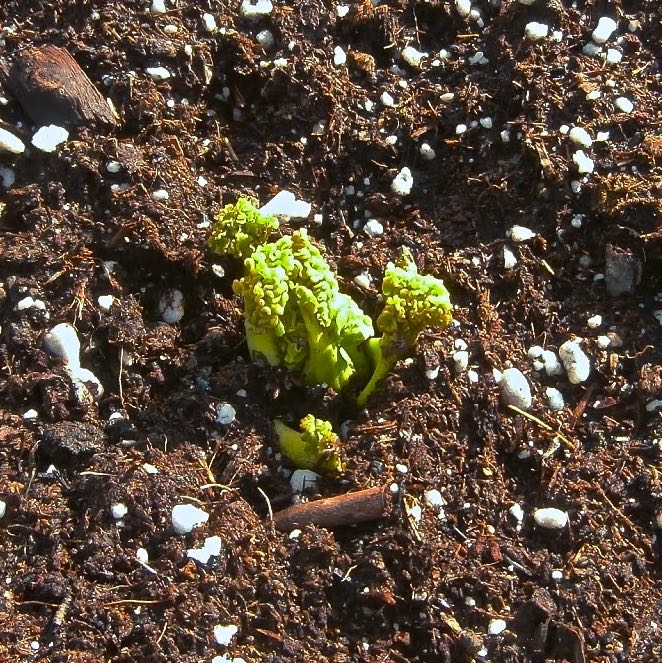
In row spacing of 24 inches (60 cm) works well, although plants may become crowded after their third year. If you intend to grow the same plants for many years and will not dig them annually to take root cuttings, you might consider a 36 inch (91 cm) spacing or perhaps thinning the plants in future years.
Seeds
You can either direct sow sea kale seeds or start them indoors. Sea kale seedlings are relatively robust and can be direct seeded in most cases. Germination is usually better indoors, so if you have a small amount of seed, that is usually the best choice. If you have plenty of seed, it will be easier to direct sow them in the spring as soon as the soil warms up to about 45° F.
I remove the pericarp (corky shell) from the seeds, which improves germination both because water can reach the seed more easily and because it eliminates the frequent empty shells. If you have obtained your seeds in the shells, you should remove them, because they can take a long time to break down naturally. A test of 400 seeds surface sown in their pericarps found no germination after one year (Scott 1958). In my experience, results with intact seed are usually better than that, but significantly worse than with shelled seed. A small pair of wire snippers is a good tool for removing the shells by hand. Plant the seeds about 1 inch deep (2.5 cm), water well, and provide 60° F (15 C) bottom heat if ambient temperature is not already warm enough. Expect germination within two weeks. Even under strong light, seedlings tend to grow leggy, so you should transplant them at least once, burying up to the cotyledons.
Optionally, you can do your first watering with a saturated solution of non-iodized salt (pickling salt) in water. The salt will remain in the potting soil, doing no harm to the seedlings, but can help to prevent problems with seedling diseases. To be clear, salt does not improve germination or health of seedlings directly (de Vos 2010) but in my experience it did appear to reduce problems with the seedlings such as damping off, probably by making the soil less hospitable. Subsequent watering should be done only with fresh water. I didn’t consider the results impressive enough to continue this practice.
Germination may be improved by salt stimulation: pre-soaking the seeds in salt water. In one study, soaking the seeds (with pericarp removed) for 35 days in 150% salt water more than doubled germination (Woodell 1985). This may be a useful technique for germinating old seed. Some sources recommend stratifying sea kale seeds, but I have seen little difference in germination between fresh and stratified seed.
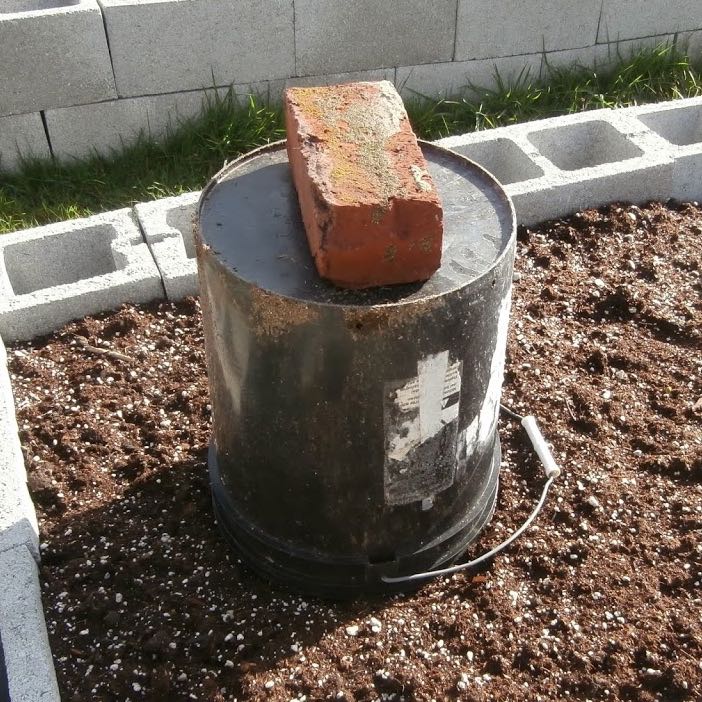
Thongs
Plant any time from the middle of fall to late spring. If the soil is workable, you can plant sea kale thongs.
Soak the thongs in water for an hour. Dig a hole deep enough for the thong to stand vertically in the soil with the top (thickest) end one to two inches below the surface. Although not every producer does this, the convention with thongs is a flat cut at the top and a slanted cut at the bottom to aid with orientation when you plant them. There is probably no big problem with planting them upside down, they will just take a little longer to emerge. Cover, water in, and wait. Under the soil, the top end of the thong will thicken and then produce sprouts which will reach to the surface. Thongs can be quite slow to get started in the spring, but once they sprout, they easily outpace plants grown from seed.
Management
In late winter or early spring, sea kale will send up new shoots. Shoots that are exposed to sunlight will be bitter, sometimes extremely so. There are two activities involved in harvesting sea kale shoots, although the terms are sometimes used synonymously: blanching and forcing.
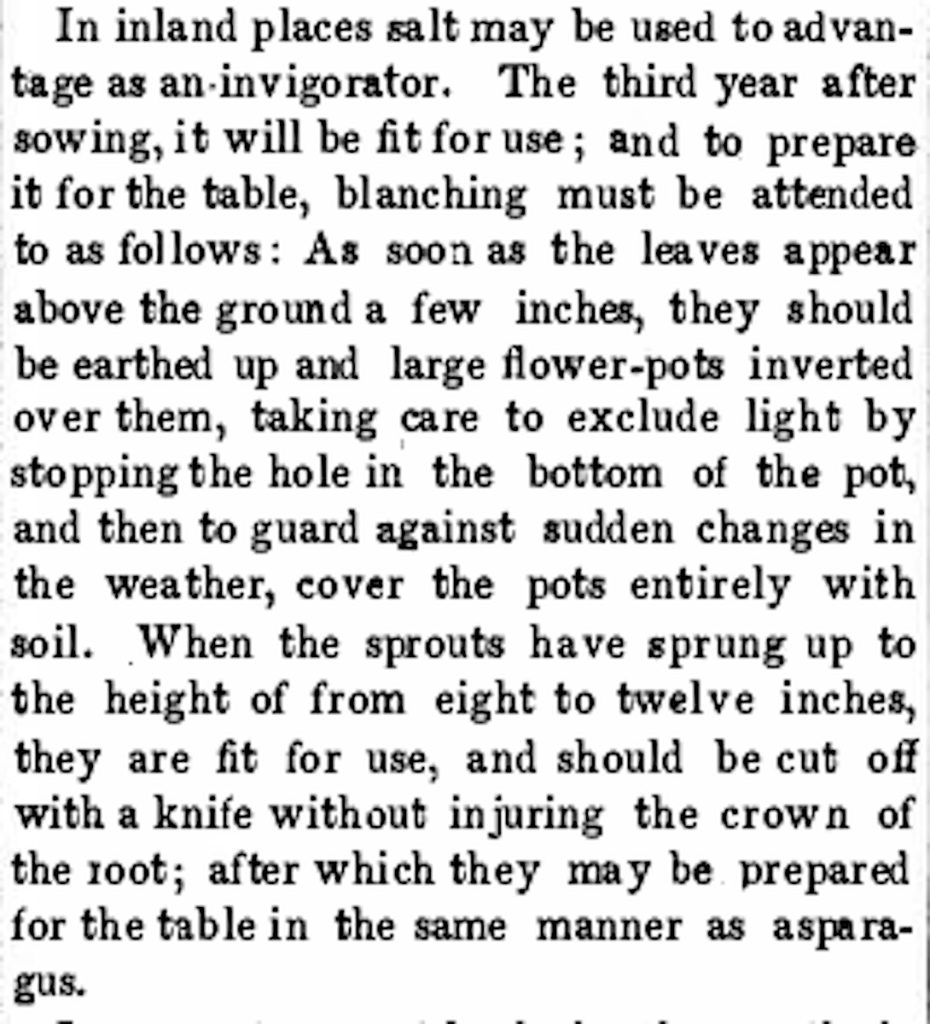
Blanching
Blanching is achieved by covering the dormant or just sprouting plant with a light proof container for three to four weeks. During this time, the shoots will grow in the dark, reaching about eight inches (20 cm) in height. They will be white with purple tips. Many rules have been proposed for how many times you can repeat the blanching process. All of them will lead you astray if you are in the wrong climate or in the right climate in the wrong year. I think it is best to subject plants of two years or older to one month of blanching. That’s it. You can push it. Sometimes you can get away with two or even three months of blanching with a strong, older plant, but I don’t know if that is really sustainable year after year.
Forcing
Forcing is persuading the plant to come out of dormancy so that you can blanch shoots at an unusual time. Traditionally, sea kale plants were dug at the end of the season and moved into heated greenhouses where they would sprout during the winter. This way, blanched shoots could be produced all through winter and spring. I’m sure this is great if you have a passel of servants maintaining the grounds of your estate, but I think a month or, at most, two months of sea kale shoots each year should satisfy most people. The limited growing season makes them more special. If you are determined to force sea kale, growing in 5 gallon containers works reasonably well and they can be moved without too much trouble.
If you have forced sea kale shoots, don’t allow the plant to flower that year. The stress of forcing and flowering can kill a sea kale plant. It won’t happen immediately in most cases, but the plants tend not to return the following spring. Shoots or seeds, not both.
Companion Planting
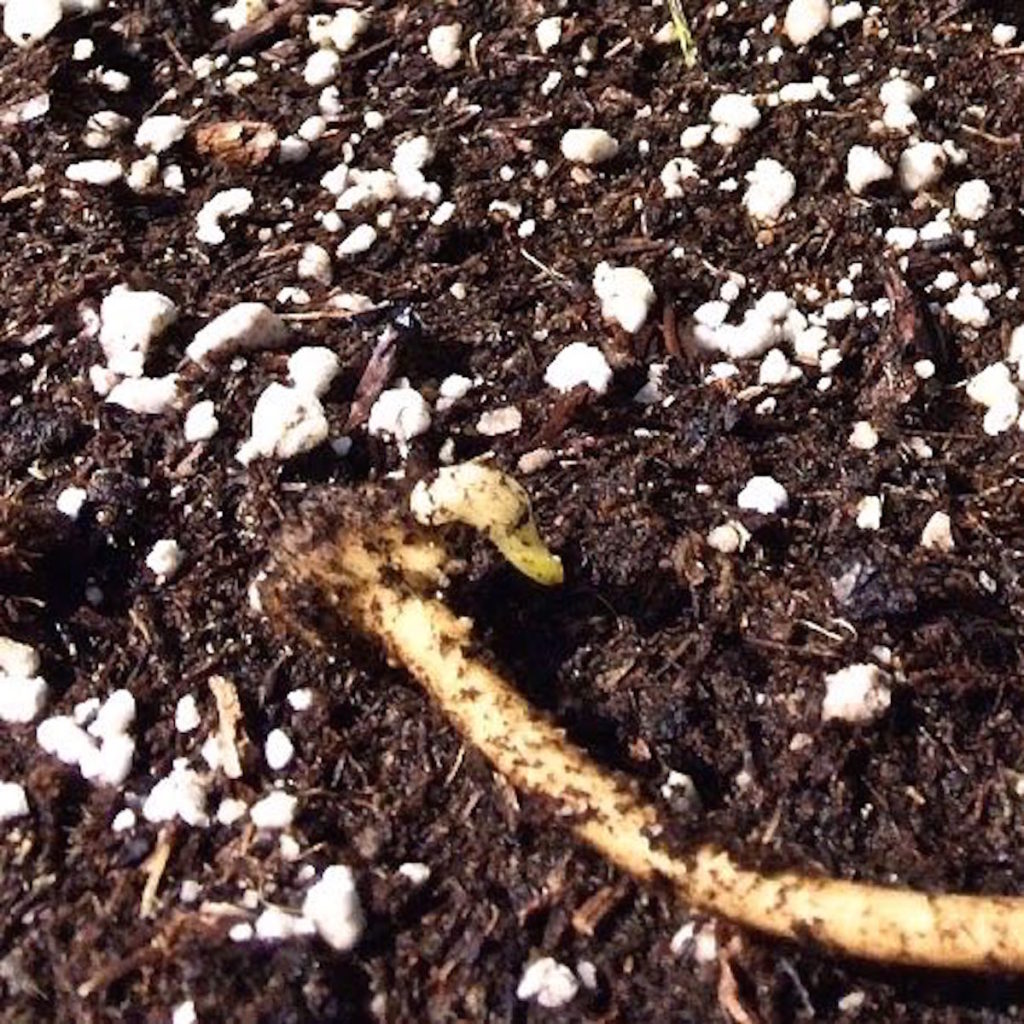
Although the plants don’t particularly benefit one another, I find that sea kale and rhubarb make a good pairing. They have a similar size, they will tolerate similar soil conditions, and harvest and seed collection take place at about the same time, which means that you’re more likely to notice when they need attention.
Growing as a Perennial
Sea kale is a true perennial and will live in your garden for many years if you treat it gently. If you push it for every last shoot, are aggressive in taking root cuttings, and let it go to seed when its energy reserves have been depleted, it will often last only three years. Older sea kale plants are very productive; take care of them and they will take care of you.
Container Growing
Sea kale has a really extensive root system and this makes it a poor choice for container growing. If you give it a large container and you dig it to prune the roots each year, it can work, but the plant will never be as productive as a plant grown in the ground. Forced plants were typically grown in pots, but I suspect that those plants died after forcing more often than not.
Harvest
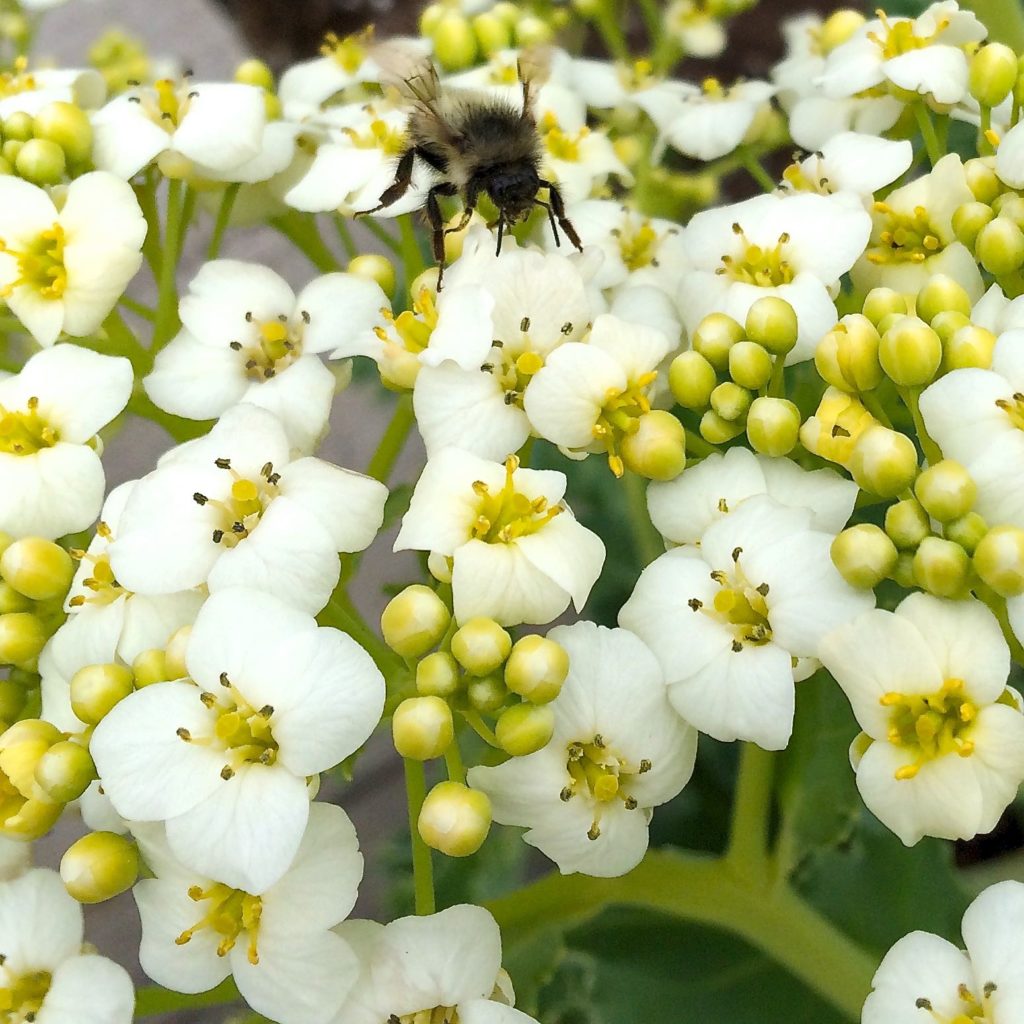
With so many edible parts, you’ll have to make up your mind about what you want to eat before harvest. Most people will be interested in blanched spring shoots. Those are ready after three to four weeks of blanching. You can take a quick peek at them without damaging the quality, but don’t leave the blanching container off for more than a few minutes.
Florets are often ready for harvest by May here. Timing will vary with climate, but you should see them forming in spring. Either cut at the base of the flower stalk for the whole head, or selectively prune out florets if you want to leave some on the plant to flower.
Roots are best harvested in the winter at the same time that you would propagate the plant. I typically take the top six to ten inches (15 to 25 cm) of root for eating and use the thinner, lower portions for propagation.
Sea kale and many other Crambes are tumbleweeds, as you will discover if you leave plants to dry down completely in a windy climate. If you wait too long, an entire seed crop can tumble away in high winds.
Storage
Other than possibly storing some roots in the refrigerator for eating, there is little reason to try to store any of the products of sea kale. They are best kept on the plant until you are ready to eat them. Sprouts and florets don’t keep for more than a day without a decline in quality. This is local, seasonal eating; make the most of it!
Preservation
I know of no preservation methods for sea kale products and can’t really think of any that I would want to see preserved either. The leaves perhaps could be prepared the same way that kale chips are, if you go in for that sort of thing.
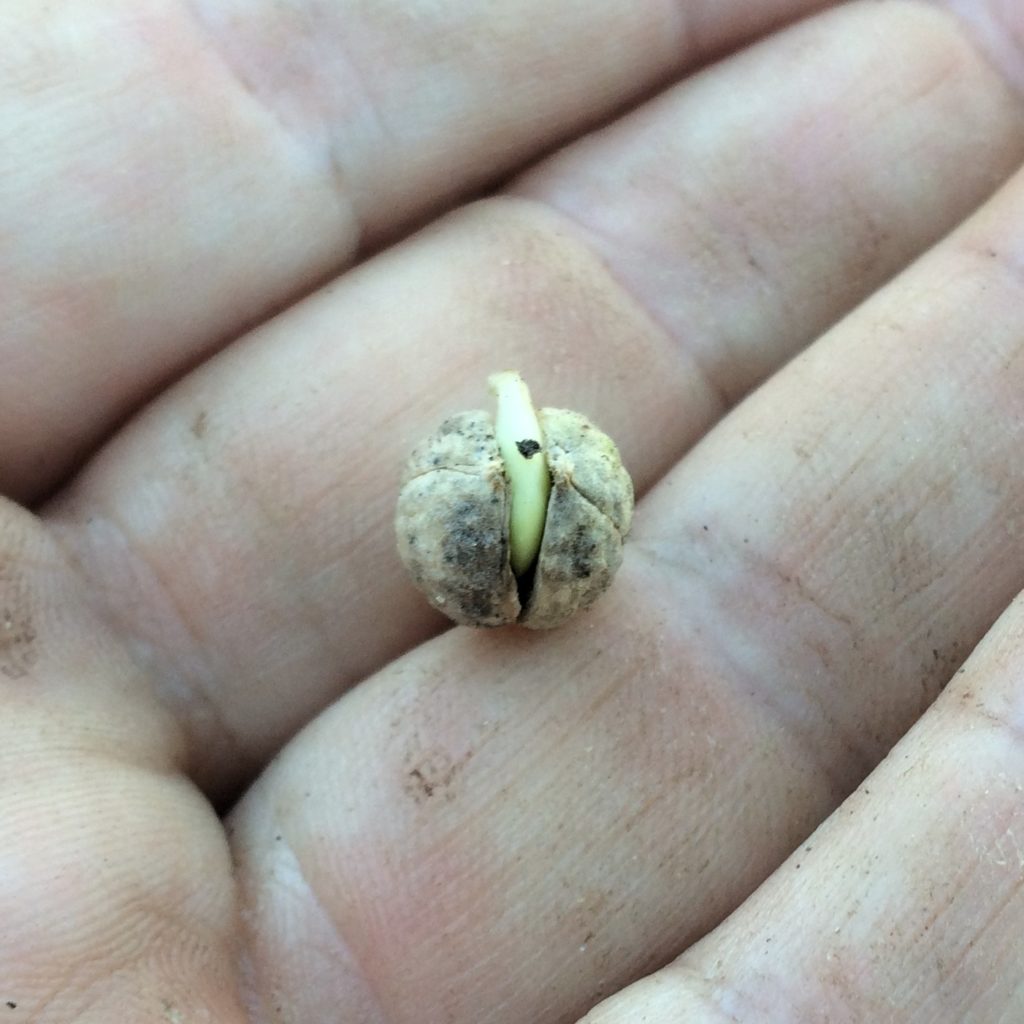
Propagation
Sea kale is a an autopolyploid of tetraploid configuration (Rudloff 2011). Varieties are clones that can only be maintained through cuttings.
Vegetative Propagation
You can begin taking your own thongs (root cuttings) in the second year. Taking root cuttings from first year plants is not recommended.
Sea kale exhibits polar organogenesis, meaning that it sprouts from the top end of root segments (Bowes 1976). This is the reason why thongs are cut so that you can tell the top from the bottom.
Sexual Propagation
Seedlings may require as much as five years to first flowering (Scott 1976) but I usually see flowering in the second year and occasionally even the first. If you allow the plants to flower, they will produce hundreds to thousands of seed capsules. Each flower becomes a green fruit which dries to the familiar corky capsule containing a single seed.
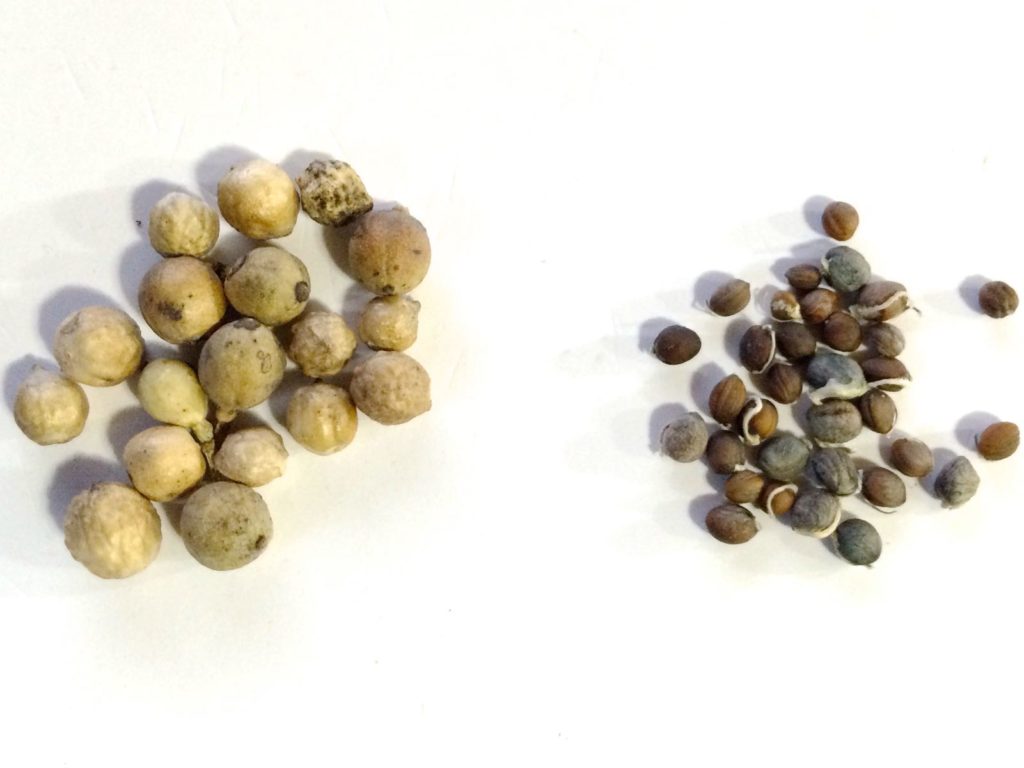
Flowering generally begins in April and concludes in June. There is a great deal of insect interest in the flowers, so cross pollination can be achieved without the need for human intervention. Bumble bees, honey bees, flies, wasps, and other native pollinators all visit sea kale flowers. In most cases, there is no need to isolate different varieties, since sea kale is polyploid and the progeny will not be true to type even if seed is pure. When making controlled crosses between varieties, they should be grown together and netted to prevent insect pollination. Wind pollination does not appear to be a problem with sea kale.
Sea kale will make seed capsules whether or not the flowers are pollinated. Clones are self-incompatible to some degree, so if you only have one clone, that means reduced seed set. Flowers that were not pollinated will make empty capsules. There is no way to tell the difference, short of opening them. Some people have suggested that larger capsules are more likely to be full, but I have not observed this to be true. The only way to be sure is to open the capsules. It is a fairly common experience for people to report opening all of the capsules in a packet of seed (not ours) only to find them empty! So, before you rely on stored seed, you should open a random sampling and make sure you don’t have a bunch of blanks.
Averaging several years of data, our plants produce about 300 seeds when they flower in the first year, 1200 seeds the second year, and 3300 seeds in the third and later years. Not all of those seeds are full though and I haven’t tracked the percent that are empty by year.
Problems
Pests
Slugs. Nothing else really bothers sea kale here, but slugs will move in and use it for food and housing. They are also extremely fond of getting into your blanching pots and eating your spring shoots before you have a chance at them.
There are many insect pests of Brassicas that will feed on sea kale, but they tend not to build up sufficient populations early enough in the growing season to cause a big problem. Harlequin bugs (Murgantia histrionica) have been reported as a problem (Smith 2010).
Diseases
A bacterial stem rot is widely reported, particularly in plants grown in garden soils, although it appears to be primarily a cosmetic concern as plants continue to yield well (Scott 1958). Improving drainage is a probable remedy for such problems. I have never seen it in our garden.
Clubroot can affect sea kale, although the plants typically survive infection for a long time if the roots were established before infection. Seedlings planted into clubroot infected soil will fail to develop good root crowns and die or grow very poorly. If you grow other Brassicas and have seen clubroot, it would probably be a good ideal to keep sea kale well separated from your Brassica ground since it could act as a perennial source of inoculum.
I have received a positive for Turnip Mosaic Virus (TuMV) in a plant showing leaf yellowing and early senescence. In addition, Cauliflower Mosaic Virus (CaMV) has been reported to infect sea kale and an unidentified member of the Caulimovirus genus (possible CaMV) has been shown to transmit to seedlings, possibly in the seed coat. It is likely that many of the same viruses than infect Brassicas will also infect sea kale, but this is a bigger concern in sea kale because it is perennial.
Defects
Seedlings sometimes come up albino. There is nothing that you can do for them; they’re goners.
Crop Development
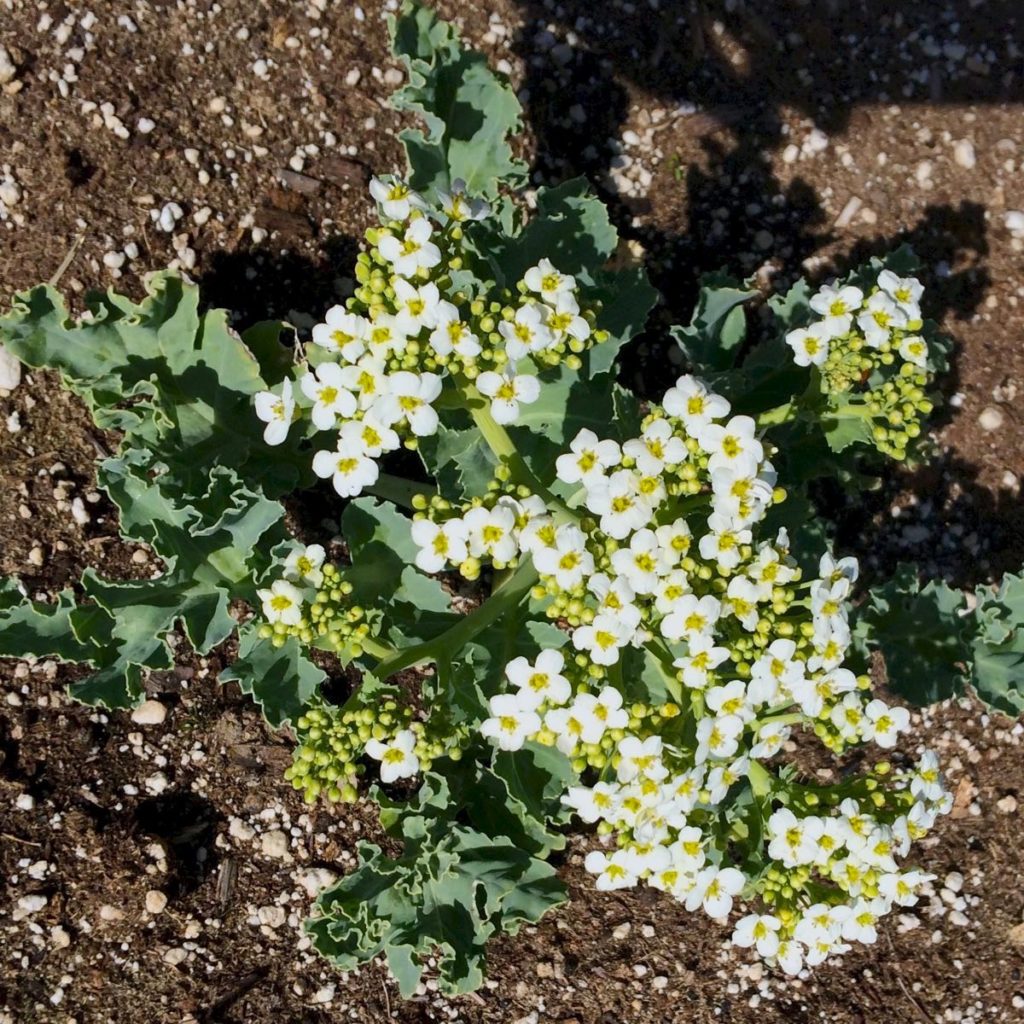
There are many directions that one could take with sea kale development, which makes it a particularly fun plant to work with. You will never get bored trying to breed new creations out of sea kale!
The most obvious goal would be to produce varieties that have improved sprout production for blanching. How to get there? Vigorous, fast growing clones that efficiently convert sunlight to root mass will allow more sprout blanching sooner. Varieties that produce taller sprouts would also be nice. Plants with stronger dormancy would sprout later, extending the season without exhausting the plants.
Production of larger florets would be well worth working on. They are as tasty as broccoli, just without the large heads. Still, plants entering their third year and later can produce a lot of florets. If the size could be improved, this could easily become a perennial broccoli with greater production.
Reducing the bitterness of the leaves would introduce the possibility of using sea kale for cooked greens, or even raw greens if the new growth were harvested in stead of blanching the shoots.
Sea kale is also a root crop! The roots taste a bit like rutabaga. The problem is that they tend to get fibrous as the plants get older. So, you could try for fast first year root bulking to get non-fibrous roots or you could try to reduce the fibrousness of perennial roots.
Sea kale has several close relatives that are also used as edibles and hybridization between these species could result in novel traits. The other edible Crambes include C. orientalis (horseradish like roots), C. cordifolia (roots and foliage), C. tatarica (roots), and C. kotschyana (roots) (Rudloff 2011). C. tatarica is evolutionarily the closest of these to sea kale and also has compatible chromosome numbers (Sanyal 2015), so will likely be the easiest cross. Most of these species have different levels of ploidy than C. maritima, but that’s part of the adventure!
It is worth noting that genetic modification of C. abyssinica has been proposed for production of commercial oilseed crops, so the presence of GMO Crambe may have to be a consideration for seed saving in the future (Carlsson 2006).
Relatives
The Crambe genus is full of exciting potential. The species detailed below can generally be grown using the same techniques already described for sea kale. This section provides specific details for each species where they differ.
Giant Colewort (Crambe cordifolia)
A close relative of sea kale, but much larger and more toleraant of warm summer temperatures. Giant colewort can grow up to five feet tall, with a similar diameter. Much like sea kale, all parts are edible, although there does not appear to have been much use of the roots historically. That is probably a good reason to stick to small portions. The florets and leaves are also edible and almost indistinguishable from sea kale. Spring shoots can be blanched just as with sea kale. The flavor seems to be a little milder. I think this makes them less interesting, but if you can’t grow sea kale or if you think sea kale shoots are a little too bitter, try giant colewort.
Giant colewort can be propagated from seeds or thongs, just like sea kale. The seeds are probably the easiest to germinate of the edible Crambes. You don’t need to do anything special; many will germinate in about two weeks at a soil temperature of 60 to 70 F (15 to 21 C). You can increase the germination percentage by stratifying under cold and wet conditions for 30 days, followed by sowing in pots at about 70° F (21 C) day and 55° F (13 C) night. Germination of fresh seed should be close to 100% under those conditions. Thongs can be taken exactly as with sea kale.
As with the other Crambes, giant colewort seems to perform best in alkaline soils, so will usually benefit from some lime in the Pacific Northwest. This plant can have some trouble with strong wind. The stems of larger plants may snap or bend, so consider planting in a sheltered location or staking.
Crambe juncea
The case for edibility of Crambe juncea is a weak one. C. juncea was once considered to be part of C. orientalis. The plants are quite similar and grow in the same region. My feeling is that, since the plants are difficult to tell apart, grow in the same region, and haven’t been identified as having important differences by the people who used them, they are probably equally edible. Taxonomy is a modern invention and we classify many plants differently than their traditional consumers. I have eaten a small portion of the leaves without ill effects, but I don’t recommend that you try it until better evidence is uncovered.
Crambe orientalis
Crambe orientalis is similar to C. tataria, but with more deeply incised leaves and a root that is said to taste like horseradish. I am honestly not sure if I have grown this plant. Some of the varieties of C. tataria that I grow have horseradish like roots, so I suspect that they are really C. orientalis. Given the similarities between the two plants, it is possible that collectors misidentified them.
Tartar Bread Plant (Crambe tataria)
Crambe tataria or C. tatarica, also known as steppe kale or katran. A close relative of sea kale and very similar overall, although Tartar bread plant is not a seaside plant and tolerates a wider range of temperatures. As with sea kale, all parts of the plant are edible. Traditionally, the roots are the most commonly consumed part. There is considerable disagreement about how the roots are suppoed to taste. In English sources, they are usually described as having a mild rutabaga-like flavor when cooked. In Russian and eastern European sources, they are usually described as tasting like radish. In my experience, most taste like radish, although I would be very interested in finding a variety with mild flavor. In eastern Europe, roots have reportedly been canned and used as a radish substitute. The leaves are thinner than those of sea kale, nearer to kale or cabbage, and they are very spicy. They make a nice addition to salads.
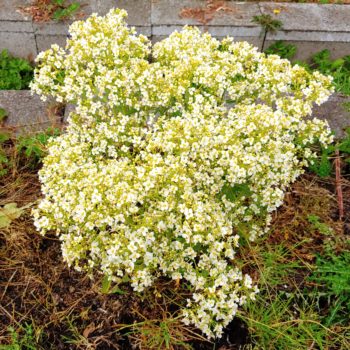
The name refers to the traditional practice of drying and grinding roots to make a sort of flour. The root of this plant is thought to be the same as what the Romans called chara, from which they made a sort of bread. (Chara shows up in Caesar’s commentaries, when his soldiers throw loaves of chara at the troops of Pompeius to show that they were well provisioned.) All parts are edible raw or cooked and they can generally be prepared just like sea kale. Sturtevant reported that the roots grow to the thickness of a man’s arm, but they probably take several years to get to that size. Ours grow at about the same rate as sea kale roots. This plant is sometimes suggested as a horseradish substitute, as is the related C. orientalis. Some of the raw roots do taste of horseradish, particularly if the plants haven’t been frosted, but this may be a result of confusion with C. orientalis or hybridization between the two.
Tartar bread plant can be propagated from seeds or thongs, just like sea kale. Unlike sea kale, the seeds are sometimes difficult to germinate. The seeds that we have saved here have germinated at 60% or more, but my original seed sources were pretty old and germinated poorly. I had the greatest success germinating old seed by performing cold, moist stratification for 30 days, followed by sowing in pots at about 70° F (21 C) day and 55° F (13 C) night. This doubled the germination rate from just under 5% to just over 10%. As with sea kale, seeds should be shelled before stratification or sowing. Thongs can be taken exactly as with sea kale. Plants emerge here about a month earlier than sea kale, in mid-winter.
Tartar bread plant seems to perform best in alkaline soils, so will usually benefit from some lime in the Pacific Northwest. I grow it in a bed built up from neutral soils, rather than in our native, highly acidic soil. Optimum spacing appears to be about 2 feet on three foot row spacing. Second year root yields have been reported to average 3 pounds and third year yields average 8 pounds (Peregudt 1970). In my experience, this species is not reliably perennial; some plants are biennial. Whether this is genetic or a consequence of less than ideal conditions, I am not sure. This plant requires very well drained soil in the winter. In soaking wet soil, the roots will rot and the plants will often not survive. If you have really wet conditions, consider growing in sandy soil in a raised bed. Otherwise, consider lifting the crowns or taking thongs in fall and storing them over the winter.
27 thoughts on “Sea Kale and Other Crambes”
Leave a Reply
You must be logged in to post a comment.

The best website on vegetables i have ever seen…..plenty of information of every kind….history, how to grow, how too cook…Thank you!!
Thanks Paolo! I’m glad that you find it useful.
This is great information! I especially appreciate the list of similar plants, several of which I look forward to trying! I would add, however, that I eat the leaves throughout the season just as I would an ordinary kale – without blanching. I never bother blanching. I just eat them – both cooked and in a kale salad (sliced thinly and muddled with lemon juice, slivered almonds, salt and olive oil). I find sea kale milder than ordinary kale and much more chewable. I often find myself breaking off a bit in the garden and eating it raw. Perhaps I have a particularly mild variety or maybe more of a taste for Kale than some. If you like Kale, give it a try!
Thanks for your comment, Karl. I also eat sea kale leaves throughout the growing season, but every time I recommend that, I hear from people who tell me how terrible it is. It may have something to do with climate, or perhaps with sensitivity to bitter flavors.
Mr. Whitson, great website. I am intrigued with the ‘Crambe tartaria’ but wonder if my temperature range may be a little too cold here in zone 6b/7a, extreme South West Kentucky?
Hey Fred. Thanks for the comment. Tartar bread plant comes from central Asia and looks like it ought to be OK to the US equivalent of USDA zone 4 or possibly colder. I think it should do just fine in your winters, but there is only one way to be sure…
Thanks for the reply Bill. I’ve decided to skip the seeds and try to get here early next year in time for some ‘thongs?’. I would love to add a perennial Brassica to the Apios americana in my ‘food forest.’
Any attempt to cross those different crambe? Would this be of interest?
I have yet to try making intentional crosses between Crambes, but I have seen traits that look like they might be the result of crosses. I’m interested in trying this, but I haven’t had the time yet. It isn’t clear what benefits such crosses might bring, but the different species do vary quite a bit in size, heat tolerance, and root flavor, so I think there is some potential.
Awesome page, Bill. Most informative and highly useful. I am very grateful that you took the time to share your expertise on sea kale.
Really enjoy this site, so informative and you can tell you really know your stuff. Thanks for sharing!
Love this information about sea kale, bought c cordiforlia. Can’t wait it ;)
Hallo Bill. I may be a little slow but, when in the second year, I understand to leave the plant alone until cropping stems in the third year. Do I do nothing to the plant at all in the second year, just let it grow and die back naturally?? Thanks for an incredibly detailed site. I have eaten sea kale many years ago and not seen it around the shops since. I would love to grow my own and once again enjoy the taste.
Hi Patricia. The plants will take care of themselves. They just need time to build a good root system before you disturb them.
How do you create 150% salt water? After total failure of trying to terminate the Seeds following the seed supplier direction, I’m getting desperate.
100% is sea water, which is 35 grams of salt per liter, so 150% is 52.5 grams per liter.
That said, sea kale is usually not particularly difficult to germinate. If you are having no success, try opening some of the shells. You may find that they are empty, which is a very common problem.
Hi Bill,
Thank you for the very extensive propagation info on sea kale.
I just cut some thongs from a 3rd year plant and potted them up.
Is it better to leave the top, say 1 cm, above the earth or bury the whole thong under the earth.
Also, i have put 5 or so thongs in 1 pot, maybe better to put 1 thong in 1 pot?
*May the force grow your plants*
Hi Marc. Bury the thongs completely. This will prevent them from drying out. There is plenty of energy for them to send up new sprouts. How many you grow in a pot will determine how often you need to transplant them, but probably doesn’t matter otherwise.
A great website. Can you tell me, please, if Crambe tataria was cultivated in Europe? I know that the country of origin is Hungary.
Thank you very much!
There is a small crop of sea kale at Semiahmoo spit, at the NW tip of Whatcom County, WA. It’s growing in a small county park, at the high tide line. Please do not disturb!
Thanks Virginia! These naturalized populations are of great interest to me.
I know I am a little late to the game but I am already growing Crambe Maritima and I love it. I have been unsuccessfully trying to find the Tartar Bread Plant seeds here in the US. Any recommendations as to who may sell this?
I have them every other year. Should have a batch in 2022. I’m not aware of anyone else who offers them.
Thanks for the great info! I planted one of your mixed-phenotype ten-packs in spring of ’21. Three of them survived their first (northern MN) winter and grew last year, one large and two stunted, but all three flowered. I’m right now opening capsules in search of seed. In the article above, you note that clones are self-incompatible causing reduced seed-set. My question is: reduced how much? I’ve opened about 100 capsules and found no seeds. Also, what’s a healthy capsule size? My largest ones are about 1/4″ tip to tip and 1/8″ across the middle.
My sea kale flowered for the first time this year, I planted from seed at least 3 years ago, maybe more. Now I have a ton of green seed pods. Should I cut it back?
Thought I would mention that I got a few thongs from you a few years ago (Piedras) and they are now reseeding themselves untended here in my garden at 5400′ an hour north of Reno, NV. Eastern Sierras. Easily 5′ in diameter as mature plants.
That’s great to hear. I certainly wouldn’t have assumed that sea kale would survive in that climate. I lived in Susanville many years ago, so I have some idea what your conditions must be like. Cheers!